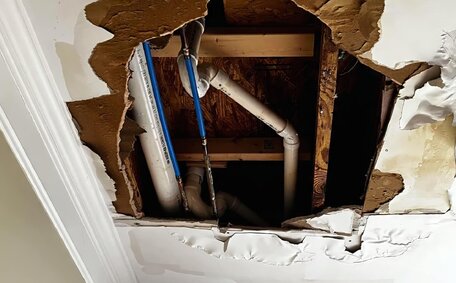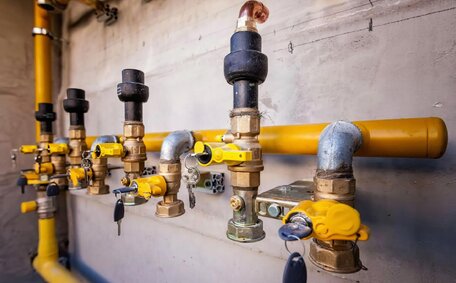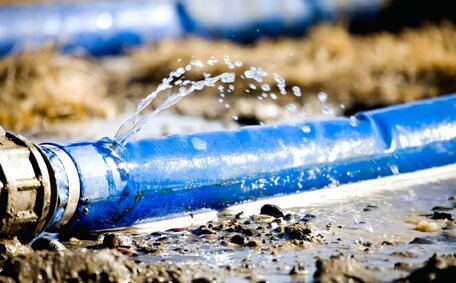Common Causes of Clogged Drains
Understanding the typical causes of clogged drains is essential for prevention:
- Hair - Strands of hair can get caught in pipes and accumulate over time, forming a blockage.
- Soap scum - Residue from soap, shampoo, and other bath products can coat pipes.
- Grease and oil - Cooking oils poured down sink can solidify and adhere to the interior of pipes.
- Food - Leftover scraps and debris can get stuck, rot, and clog drains.
- Foreign objects - Items like toys, jewellery, or excessive toilet paper inadvertently dropped down a drain.
The smallest trickle or water beginning to back up into your drain can indicate the early stages of a blockage.
Using drain catchers and strainers, Preventing oil down kitchen sinks and limiting grease disposal, gathering hair, and thoughtfully avoiding the disposal of debris, can all aid in circumventing drain blockages. Regular DIY maintenance or professional hydro jetting can prevent minor drain obstructions from becoming major issues.
Grease Buildup
Grease and cooking oils solidify upon cooling, commonly creating blockages by adhering to the inside of pipes. As hot oil, lard, or grease from meat cool, they solidify and coat the inside of pipes. Over time, thick layers form that trap other debris and narrow water flow.
To prevent grease blockages:
- Never pour fats, oils or grease down the sink. Allow them to fully cool and dispose in the garbage.
- Use paper towels to wipe pots, pans and plates to remove oils and fats before washing.
- Consider installing a grease trap inline under sinks to catch oil and solids.
- Employ sink strainers to catch any remnants of food scraps and sidestep the inconvenience of blocked drains.
- Limit use of garbage disposals as they wash debris into pipes.
Disregarding these preventive measures can lead to significant grease accumulation and severe clogs. Signs of a grease-related blockage include gurgling noises from drains, bad odours, and slow draining water. Refer to professional drain cleaning with hydro jet drain if DIY methods are unsuccessful.
Hair Accumulation
Hair accumulation is a leading cause of blockages, causing significant clogs over time. As hair sheds in the shower or sink, finding the best way to catch it becomes imperative, as it can easily become trapped in pipes. Each individual strand may seem harmless, but over time the accumulation of hair in drains forms a dense nest that ensnares other debris too.
To prevent hair blockages:
- Fit drain catchers or screens in your sink, shower, and other drainage points to effectively trap hair and prevent clogs.
- Remove trapped hair from catchers after each use.
- Consider a drain-filtering hair catcher, which can be used to permit water passage while ensnaring accumulations of hair.
- Clean hair brushes away from drains to avoid loose hair getting into drain.
- Use a zip-it style drain cleaning tool or even a wire coat hanger fashioned into a makeshift tool to remove hair from pipes.
- Don’t wash pets in sinks or tubs indoors.
Preventing drain blockages involves regular checks and cleaning of drain catchers to avoid hair buildup before a clog occurs. A monthly pass through of drains with a drain snake can fix by pulling out accumulated strands. Catching hair early is crucial to avoid serious jams needing extensive drain cleaning.
Improper Garbage Disposal
Placing inappropriate items in the garbage disposal can cause jams, often challenging our customers. Food waste like egg shells, coffee grounds, and fibrous fruit peels can get lodged and accumulate. Non-food items like glass, plastic, and metal can cause more than simple obstructions.
To avoid issues:
- Start a compost bin for most food waste rather than using the disposal
- Only deposit small quantities of soft, pulpy food residues down the drain, steering clear of the toilet
- Run plenty of cold water before, during and after using the disposal
- Never put non-food objects, grease or oil down the disposal
Being mindful of disposal usage helps prevent debris accumulating. Additionally, occasionally flushing pipes using a baking soda vinegar mix and hot water helps clean out small particles before major blockages occur.
Tree Root Invasion
Tree roots can obstruct drains and sewer pipes, so seeking guidance from a local plumber is recommended. As trees grow, their roots spread underground seeking water sources. Over time, this can lead invasive roots to make their way into cracks or joints in the sewer line.
Once inside pipes, expanding tree roots can create fissures, dislodge sections, and cause complete blockages where there’s no passage. Telltale signs of tree root invasions include gurgling sounds while draining water, bad sewage odours, or overflowing water despite limited use.
Extracting root blockages necessitates professional services employing high pressure hydro jetting to fragment and remove the tenacious wooden growth. Severely damaged sections of pipe may also need replacement through trenchless relining rather than excavation. Preventatively, ensuring drainage pipes are in good condition without cracks roots can penetrate will help avoid infestations.
For chronic tree root invasions, removal or strategic pruning of problem trees may be required. Removing aggressive root systems, while drastic, can prevent ongoing damage to plumbing infrastructure.
Stay vigilant for signs of root intrusion in sewers and reach out to a professional service for help. Seek professional plumbing assistance near you for prompt inspection and removal to avoid significant damage to your water systems over time. Prevention through proactive drain maintenance and tree management helps mitigate issues.
Preventing Drain Blockages
There are several key steps you can take to help prevent clogged and blocked drains:
- Use drain catchers and screens in the drains of your sinks and tubs to trap hair and debris before it enters pipes
- Gather grease and cooking oils in containers and then dispose of them in the trash, rather than allowing them to traverse the pipes around your home
- Limit use of garbage disposals as they wash food particles into pipes
- Use liquid hand soaps rather than bar soap to minimise soap scum and prevent blocked drains
- Maintain your kitchen drain by flushing pipes with 1-2 cups of boiling water weekly, aiding in dissolving fat deposits and eradicating soap scum
Monthly preventative maintenance is vital to prevent serious drain obstructions:
- Use a zip-it style plastic drain snake to pull out accumulated hair
- Flush pipes with a hot water, baking soda and vinegar treatment to break up organics
- Inspect sink pipes under cabinets for leaks or cracks that could lead to clogs
Understanding how to detect minor drain problems early and exercising diligent maintenance can decrease the hassle and expense related to harsh blockages down the line. Contact a professional plumber for assistance if DIY methods are unsuccessful.
Drain Maintenance
Consistent maintenance of your entire plumbing network, including hot water systems and drains, is pivotal to averting blockages and ensuring smooth flow. Some home remedies include options for free drain cleaning:
- Pouring 1-2 cups of boiling water down sinks and drains weekly. This helps melt grease deposits and clear soap scum. Caution: Avoid pouring boiling water down PVC pipes as it can damage them.
- Monthly use of a baking soda and vinegar treatment can help remedy blocked sinks, mixing 1 cup baking soda with 1 cup vinegar, pouring it down the drain, and following the rest as per usual.
- Using a plastic drain snake monthly to manually pull out debris and hair.
Checking your home’s pipes under sinks for leaks, clearing your drains with sink strainers, and avoiding harsh chemical drain cleaners also helps to keep your pipes free from serious clogs.
Contact a professional plumber if DIY drain cleaning efforts are unsuccessful or to have pipes thoroughly hydro jetted.
Hair Catchers
Hair catchers are devices that fit over drains to trap hair and prevent clogs, particularly effective in showers.
There are a few types of hair catchers:
- Sink strainer baskets catch loose hair when washing hair or cleaning brushes in the sink.
- Tub shroom catchers use a mushroom shape in drain holes to collect hair around it while allowing water to pass.
- Drain screens or mesh catchers also fit into sink and tub drains to filter out hair.
To work effectively:
- Hair catchers and drain screens need to be cleaned frequently - daily or every few uses.
- Remove trapped hair and rinse catcher to keep water flowing freely.
- Check under catchers for signs of accumulated hair in pipes.
Consistent use and cleaning of hair catchers prevents strands from amassing into clogs. They provide an easy protective barrier between hair and drains.
Avoid Harsh Chemicals
Harsh chemical drain cleaners can damage pipes and should be avoided to prevent exacerbating clogs. Though touted as quick fixes, the caustic chemicals used can damage your pipes and fittings over time. They also get flushed into the broader water system, leading to environmental harm.
Safer alternatives exist using common household ingredients like baking soda, vinegar or boiling water. Although they might require more patience, pondering 'how can i address this with natural alternatives’ assures no harm comes to pipes eventually.
When grappling with a significant obstruction, it’s time to call upon a professional plumber for expert intervention. They can employ methods like hydro jet blasting to clear your clogged drains without dangerous chemicals. Only use commercial cleaners as a very last resort once all other options have been tried.
Clearing Existing Blockages
If you have a current drain blockage, try these methods using common household items before resorting to harsh chemical cleaners:
- Carefully pour boiling water into drains blocked by grease. The heat assists in breaking down the stubborn blockages and clearing away soap residue. Be cautious not to splash yourself or damage PVC pipes.
- Make a baking soda and vinegar treatment by mixing 1 cup baking soda with 1 cup hot vinegar. Pour the mixture down the drain, let sit for 30 minutes, then rinse with more hot water.
- Use a plastic drain snake to manually pull out hair and debris blocking pipes.
- Try a plunger over the drain for several minutes to dislodge clogs.
When home remedies fall short, it’s prudent to explore the professional services we offer, courtesy of our seasoned plumbing team. They can use high-powered hydro jetting to blast away stubborn obstructions without harmful chemicals.
Avoid pouring fats, oil grease, and other substances down drains. Wipe pans and dishes first. Use hair catchers and consider modifying garbage disposal usage to prevent future blocks.
Boiling Water
Pouring hot water down the drain is a reliable remedy to dissolve blockages, as advocated by our customers. The heat dissolves accumulated grease deposits, aiding in maintaining a clean and functional kitchen drainage system.
To use these drain solutions safely, especially in areas such as the kitchen sink:
- Bring a pot or kettle of water to a rapid boil.
- Carefully pour 1-2 cups of boiling water down the blocked drain.
- Repeat 2-3 times, waiting several minutes between each pour.
- Finish by flushing the drain with cool water.
Avoid using boiling water with PVC pipes, as the heat can damage plastic materials. Otherwise, this simple solution is safe for most metal or ceramic drains. Test in a small, inconspicuous section first before pouring larger amounts. If ineffective, you can try using a drain snake to manually remove hair and gunk causing the clog.
Baking Soda and Vinegar
A natural drain cleaner can be created using a mixture of baking soda and vinegar. The soda vinegar reaction between the baking soda (sodium bicarbonate) and vinegar (acetic acid) produces carbon dioxide gas bubbles, which dislodge debris and break up blockages.
To use this method:
- Pour 1 cup of baking soda down the blocked drain.
- Follow with 1 cup of heated white vinegar - the heat activates the reaction.
- Let the mixture sit 30 minutes in your drain, allowing the reaction more time to dislodge the clog.
- Make sure to rinse by pouring very hot water down the drain.
- Flush extra hot water for a minute or two to clear any remaining debris.
For obstinate blockages, you should always consider using a drain snake post baking soda and vinegar treatment to remove softened debris. Alternatively, repeat the treatment waiting longer between steps.
Over time, regularly pouring a smaller baking soda and vinegar treatment monthly can help prevent buildup and keep drains clear.
Drain Snakes
Drain snakes are flexible cables that manually dislodge deep-seated clogs within drain pipes. They range from smaller hand-cranked units for home use to larger electric powered commercial snakes.
To use a drain snake:
- Protect hands with rubber gloves to avoid dirty water or abrasions.
- Slowly feed the snake end into the opening of the clogged drain pipe.
- Crank the handle as you push the cable farther into the pipe.
- Tightly winding sections allow it to grab hair and debris, pulling out the clog.
- Remove and clean off the snake once the drain is clear.
For sinks and bathroom drains, small 5 – 10 ft hand snakes are generally suitable, which ensures debris ends up being removed, while tubs or main sewer lines may require larger machines. Consider renting an electric powered drain auger for extensive blockages.
The adaptable design of drain snakes navigates P-traps and bends, showing you the most effective ways to unblock drains. Caution is needed to effectively unblock drains without scratching fixtures. Regular monthly use demonstrates how to unblock drains and prevent major clogs.
When to Call a Professional
Blocked drains can be frustrating for homeowners, and there are limits to DIY methods. If attempting solutions like boiling water, baking soda mixes, or manual drain snakes doesn’t solve the issue, it’s best to call in professional help.
Signs it’s time to contact Lindfield Plumbing include:
- Water backing up despite efforts to clear it
- Foul sewage odours coming from drains
- Multiple drains clogged throughout the home
- Outside cleanouts overflowing
- Slow draining not fixed by hair catchers
For severe or recurring blockages, our team is equipped with high-powered jetting equipment and augers to clear even the toughest obstructions. We inspect pipes after clearing them using advanced cctv drain camera technology to ensure no underlying complications remain.
Don’t wait for flooding damage or health hazards from sewer gases. Phone 1300 349 338 or email [email protected] to schedule affordable drain cleaning services when DIY methods fail. Our expertise provides long term solutions, ensuring the health of your pipes for years to come.
Signs of Serious Blockages
There are several signs blocked drain is too severe for DIY solutions and requires professional help:
- Water backing up in multiple drains or in unusual places, such as a blocked toilet drain
- Bad sewage odours persisting despite attempts to clear the blockage
- Gurgling sounds coming from multiple drains
- Exterior cleanouts overflowing
- Slow drainage not improved by hair catchers or drain snakes
- Large patio areas pooling with water from underground pipe backups
Experiencing any of these stubborn issues means there is likely a major clog or collapse deeper in the main plumbing pipes beyond the reach of basic at-home methods.
Our team has the high-powered hydro jetters, augers and CCTV cameras to thoroughly clear even severe obstructions. We can also inspect pipes to check for cracks or broken sections needing repair or replacement.
Contact our team at Lindfield Plumbing on 1300 349 338 at the first signs of serious drainage problems. Our plumbers, equipped with advanced tools and expertise, can assist in clearing blocked drains and resolving complex clogs to restore proper flow.
Recurring Clogs
Frequent clogs point to deeper issues necessitating professional assessment and repair. Repeated blockages happening after attempting DIY solutions can mean:
- There is a larger obstruction or collapse in main sewer pipes.
- Smaller clogs are reforming around an undetected crack.
- Invasive tree roots have grown into the drainage system.
Our team, skilled in both plumbing and gas fittings, has high-powered hydro jetting equipment and drain cameras to fully clear recurrences and identify their root cause. We can patch cracks, replace damaged sections, or employ pipe relining to permanently resolve repeat clog situations.
It’s time to call in experts when you don’t want to tolerate regular blockages in your sink, shower, or elsewhere resulting in flooding or foul odours. Dial 1300 349 338 today so our dedicated plumbers can tackle the issue and provide comprehensive solutions for long-term blockage prevention.






